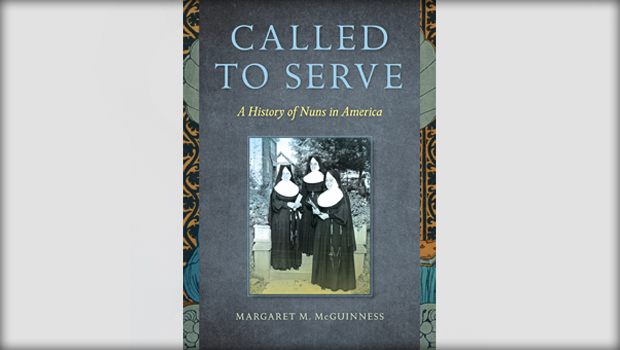Reviewed by
Sister Mary Jo Larkin, SSJ
When one finds a book that offers readability along with well-documented scholarship, it is a remarkable discovery. Such is the case in Margaret M. McGuinness’ newest publication Called to Serve: A History of Nuns in America.
McGuinness, a Professor of Religion at LaSalle University in Philadelphia, presents a “collective study” of the ministries and efforts of religious women in the United States from the arrival of the Ursulines in New Orleans in 1727 to the diverse ministries of contemporary religious women such as Sister Mary Scullion who co-founded Philadelphia’s Project H.O.M.E. and Sister Helen Prejean the inspiration for the book and film Dead Man Walking.
The book’s earliest chapters chart the challenges facing Sisters, some of whom left homes in Europe to join American religious communities in addressing the needs of a rapidly growing country of poor and needy immigrant populations.
The demand for schools, hospitals and social services drove these women to contend with a variety of obstacles ranging from personal danger and deprivation to disputes with church hierarchy and civil authority. Welcome or not, these sisters played a vital role in the growth and development of the Catholic Church in the United States.
McGuinness devotes individual chapters to the services these religious offered to an increasing population, Catholic and non-Catholic alike. She devotes a chapter to the efforts of teachers, of nurses, of social service workers and of contemplative sisters.
Drawing on the wealth of her research, she colors her narrative with examples and quotes found in the archives of the dozens of communities she consulted in her research. For instance, she mentions that the first Sisters who came from Europe to teach Italian, German and Polish immigrants arrived in classrooms before they had mastered English, sometimes frustrating parents and church leaders. She quotes a German sister who asked that “God may loose my tongue and let me hear right…without a miracle I shall never know English.”
She points out that Elizabeth Seton’s Sisters of Charity were the first to offer a formal ministry to the sick in this country and that the Sisters of the Good Shepherd were not supported by clerical leaders in New York City because they worked with “troubled” women.
In describing the various contemplative orders that gradually took root in the United States, Dr. McGuinness reveals that their ministry was not readily welcomed by all American bishops who preferred to support active communities. Late in the 1800’s, Poor Clare nuns attempting a foundation in Philadelphia were refused by Archbishop James Wood as being “unsuited to the Catholic Church in (Philadelphia).” In spite of early challenges contemplatives eventually flourished across the country serving it by praying for the church and the world.
The final chapters address the work of religious women since Vatican II. Responding to exhortations from Popes Pius XII and Paul VI, as well as directives of the Second Vatican Council, American sisters examined their lives to adapt to the needs of a rapidly changing world. They relinquished traditional works that could be assumed by others in order to meet the challenges of the present day.
McGuinness describes how this focus on the “signs of the times” has led them to risk disapproval from many to speak out against issues of injustice and inequality, and to pursue efforts toward environmental responsibility and global sustainability on local and national levels.
Acknowledging that the sisters’ adherence to the Popes’ and the Council’s mandate about responding to the “signs of the times” has brought about visible changes in the way sisters minister, she predicts that their service will meet the needs of a contemporary American Church in the same way that way that it has always done.
She points out that along with feeding the hungry and clothing the naked, today’s sisters are also addressing the issues that result in people being hungry and homeless, even when they risk scrutiny such as that of the 2009 apostolic visitation.
Called to Serve is an inclusive, balanced and well-written history. Its abundant notes make it a treasure for researchers and its readability offers a three-dimensional narrative to readers interested in the American Catholic Church and the contributions of religious women.
Sister Mary Jo Larkin, SSJ, is Dean for Library & Information Resources at Chestnut Hill College

